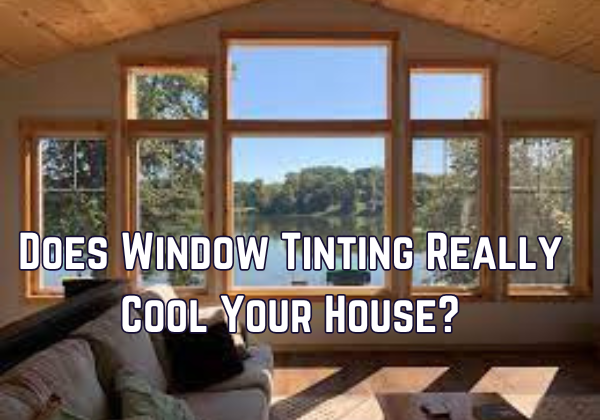If your home heats up fast during the day, you might wonder:
“Will tinting my windows actually help cool things down?”
Short answer: Yes. It can make a big difference.
But how much it helps depends on the film type, your windows, home layout, and even the sun’s direction.
This article explains how residential window tinting works to reduce heat and whether it’s a worthwhile investment for Greenville homeowners.
Key Takeaways
-
Window tinting can reduce solar heat gain by 30%–80%.
-
It blocks infrared heat, glare, and 99% of UV rays.
-
Cooling impact is most noticeable in sunny rooms and west-facing windows.
-
It doesn’t replace insulation or AC, but makes both work more efficiently.
-
Film performance varies by type, quality, and glass compatibility.
What Causes Heat Inside Your House?
Understanding where heat comes from helps explain why tint works.
Heat enters through:
-
Solar radiation: Sunlight transfers heat directly through windows.
-
Infrared (IR) rays: These are invisible heat waves that make your space feel warmer.
-
UV rays: They damage furniture and floors and contribute to heat gain.
-
Hot air: Poor insulation or gaps in windows let warm outdoor air seep in.
Windows are often the biggest weak point in keeping your home cool.
In fact, up to 76% of sunlight that hits double-pane windows becomes heat, according to the U.S. Department of Energy.
How Does Window Tint Reduce Heat?
What Window Tinting Actually Does:
1. Blocks Solar Heat
High-performance window films reflect and absorb a portion of solar energy especially IR rays, which cause most heat buildup indoors.
2. Filters UV Radiation
Most modern window films block 99% of harmful UV rays, protecting interiors and reducing thermal gain.
3. Lowers Indoor Surface Temperatures
By cutting sun intensity, window tint keeps surfaces like sofas, floors, and countertops cooler to the touch.
Temperature Drop Example
| Room Type | No Tint | With Quality Tint | Heat Reduction |
|---|---|---|---|
| West-facing Living Room | 89°F | 78–80°F | 8–11°F difference |
| Sunroom (glass walls) | 93°F | 81–83°F | 10–12°F difference |
| Home Office (afternoon sun) | 86°F | 76–78°F | 8–10°F difference |
Note: Actual results depend on film type, glass type, and sun exposure.
What Kind of Window Film Works Best for Heat?
Not all tint is created equal.
Here’s how the most common types stack up:
| Film Type | Heat Reduction | Best For | Notes |
|---|---|---|---|
| Dyed Film | Low (10–30%) | Budget-conscious users | Mostly cosmetic, limited heat control |
| Metalized Film | Moderate (40–60%) | Heat + glare reduction | Reflective look, may block cell signal |
| Ceramic Film | High (60–80%) | Premium residential & commercial | Clear or lightly tinted, no signal loss |
| Spectrally Selective | High (up to 80%) | Visible light + heat balance | Expensive, but optimal performance |
Pro tip: Ceramic and spectrally selective films are ideal for large windows, sunrooms, and offices where heat buildup is a problem.
Learn more about reducing heat transfer through your windows with different solutions.
Does Tint Replace Air Conditioning?
No, but it helps reduce the need for AC.
Window film is not a cooling system, but it helps keep cool air in and heat out.
Impact on HVAC:
-
Lowers indoor heat gain, so your air conditioner doesn’t work as hard
-
Improves energy efficiency, especially in rooms with large windows
-
Reduces hot spots, making indoor temperatures more consistent
According to LLumar’s energy data, some buildings have seen up to 15% HVAC savings after installing heat-control window film.
Common Questions About Heat Control Window Film
Will tinted windows make my house too dark?
Not necessarily. Modern films come in clear or nearly invisible options that reduce heat without blocking natural light.
Can tint reduce glare too?
Yes. Many films cut glare by 40–90%, especially on TVs, laptops, and glass tabletops.
Will it help in winter too?
Yes, but less. Some films offer insulating benefits to reduce heat loss in colder months.
Look for low-emissivity (low-e) window films if winter efficiency is a concern.
Real Benefits Beyond Cooling
Tinting your home or office windows can also:
-
Protect furnishings from sun damage
-
Extend the life of floors and upholstery
-
Improve comfort in high-use areas
-
Add privacy without heavy window treatments
It’s a small change with wide-reaching benefits both immediate and long-term.
Summary: Does Window Tint Really Cool Your House?
Yes, it does.
Window film works by reducing the amount of solar heat entering your space. That means a cooler home, more comfort, and lower energy costs.
Here’s the recap:
-
It blocks infrared and UV rays, reducing indoor temperatures
-
Works best with ceramic or spectrally selective films
-
It doesn’t replace AC, but helps it work smarter, not harder
-
Keeps rooms cooler, especially those with direct sun exposure



